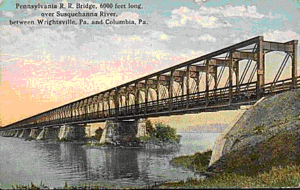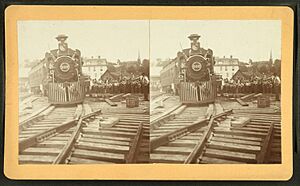Pennsylvania Railroad Bridge (Columbia, Pennsylvania) facts for kids
Quick facts for kids Pennsylvania Railroad Bridge |
|
|---|---|
 |
|
| Coordinates | 40°01′45″N 76°31′04″W / 40.0293°N 76.5179°W |
| Carries | railroad tracks and two-lane automobile roadway |
| Crosses | Susquehanna River |
| Locale | York County, Pennsylvania and Lancaster County, Pennsylvania |
| Other name(s) | Columbia-Wrightsville Bridge |
| Maintained by | Pennsylvania Railroad |
| Characteristics | |
| Design | prefabricated open-air steel trusses |
| Total length | 5,375 feet |
| Longest span | equal 200-foot (61 m) sections |
| Clearance below | 14 feet above flood stage |
| History | |
| Opened | 1896 |
| Closed | 1963 |
| Statistics | |
| Toll | varied by vehicle type |
The Pennsylvania Railroad Bridge was a very important bridge that crossed the Susquehanna River in Pennsylvania. It connected the towns of Columbia and Wrightsville, Pennsylvania. This bridge, and others before it, helped people and goods travel between big cities like Philadelphia and Baltimore for more than a century! It was a key part of the Pennsylvania Railroad system.
Contents
Early Bridges on the Susquehanna River
Several bridges were built in this spot over time. The first one was a huge wooden covered bridge built in the early 1830s. It replaced an older, smaller bridge that had been destroyed by ice.
The Longest Covered Bridge
This new wooden bridge was set on 26 strong stone supports called piers. It was made from sturdy oak wood. At over a mile and a quarter long, it was once the longest covered bridge in the whole world!
The bridge used wood saved from the older bridge. It was a vital link for the Philadelphia and Columbia Railroad and the Northern Central Railway. It also allowed carriages, people walking, and wagons to cross the river. There was even a special path on the side for horses or mules. They would pull boats from one canal to another across the river.
The Bridge in the Civil War
This amazing bridge was burned down on June 28, 1863. This happened during the American Civil War. Soldiers from Pennsylvania, led by Colonel Jacob Gellert Frick, burned it on purpose. They did this to stop Confederate soldiers from crossing into Lancaster County. This event happened just before the famous Battle of Gettysburg.
After the bridge was burned, people had to use ferries to cross the wide Susquehanna River. This made travel much harder for the rest of the war.
New Bridges and Storms
After the Civil War, another wooden bridge was built on the same stone piers. This brought the railroad line back to life. The Pennsylvania Railroad bought this bridge in 1879. However, a very strong windstorm destroyed it in 1896. Both of these wooden bridges were known as the "Columbia-Wrightsville Bridge."
The Pennsylvania Railroad Bridge
The last bridge built at this location was made of steel. It was finished in 1896, just 29 days after the last wooden bridge was destroyed! This new bridge was made of strong, pre-built steel sections, each about 200-foot (61 m) long.
Designed to Last
This steel bridge was built to be tough. It was designed to resist fire, floods, and ice. These were the very things that had destroyed the older wooden bridges. Like the bridges before it, people had to pay a toll to cross. This helped the railroad get back some of the money they spent building it.
Sharing the Roadway
Originally, the new bridge was planned to have two levels. The bottom level would be for trains, and the top level for other traffic. But the top level was never built. So, freight and passenger trains shared the lower deck with carriages, wagons, and later, cars and trucks. This bridge was part of the famous Lincoln Highway.
A New Era of Travel
In 1930, cars started using a new bridge called the Veterans Memorial Bridge. This new bridge was built just a little bit downstream. After that, the steel Pennsylvania Railroad Bridge was only used by trains. Over time, fewer and fewer trains used it. This was because more trucks started using the Veterans Memorial Bridge, which was part of US 30.
The train tracks were removed from the Pennsylvania Railroad Bridge in 1963, and the bridge was taken apart. However, you can still see the original stone piers standing in the river today! A special historical marker now tells the story of this important bridge.


